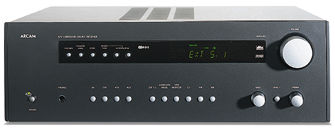Arcam DiVA AVR100 A/V Receiver
After years of lagging behind the colonies, the British are finally taking home theater—er, home cinema—seriously, and British manufacturers have started to make impressive gear using their own characteristic design approach. For years, Arcam has been made up of a bunch of die-hard two-channel-stereo types, yet the company has always been a leader when it comes to new technologies like digital radio. Although they have manufactured surround equipment for a few years now, the AVR100 is their first A/V receiver.

At $1,199, the AVR100 isn't intended to compete with those $3,000 to $5,000 super-receivers from the big Japanese companies, but it isn't really a cheapie, either. To hit their price target, Arcam took the approach we see most frequently from American and European manufacturers of paring down the facilities, instead of giving us lots of bells and whistles while compromising on the product's performance. This approach will only work with a higher-end dealer network that actually demonstrates products, rather than selling them based on feature count. Besides making the unit simple, Arcam's other key cost-savings move is noted on the little sticker on the back of the receiver that reads "Made in PRC." No, that doesn't stand for Puerto Rican Community. They went to China to have the receiver made inexpensively. Despite its Chinese origins, the AVR100 does use very good components for a receiver in this price range, with quality parts like polypropylene capacitors and metal film resistors populating the circuit boards stuffed around the big toroidal transformer.
Arcam's industrial design really hits the mark, and the AVR100 is about as sleek and elegant a design as you can find this side of Bang & Olufsen. All of the essential controls are on the front panel, and it's very easy for even the non-A/V-minded user to figure out. The same cannot be said of the remote, which is a bit of an ergonomic disaster. The itty-bitty gray buttons are labeled with even ittier and bittier black letters that are hard to read in a well-lit room and impossible to read in a darkened one. The only easy-to-use control—the large cursor pad—is used only during the initial setup. The remote is not programmable, but there are transport controls that will work with an Arcam DVD or CD player.

The amount of connections is thorough but not abundant. There are no component video inputs, but there are 5.1-channel inputs and outputs.
The provided input and output connections are probably enough for most home theater setups, but anyone with a pretty complicated rig will find the facilities a bit limited. There are four A/V inputs, two of them with VCR loops and three with S-video capability. Additionally, there are three audio inputs, including one tape loop and one 5.1-channel input that can be used for new formats like DVD-Audio. There's also a set of 5.1-channel preamp outputs. Arcam makes the point that all of their amplifiers are power- and phase-matched, so the 5.1-channel output allows for an easy upgrade to a biamplified setup, which is useful considering the rather modest power available. Digital inputs are limited to coaxial for the satellite and DVD inputs and Toslink for the VCR loop with S-video.
The speaker connectors are a bit unusual in that they're designed to meet the stringent European CE specifications, which ban banana plugs because some bureaucrat thought kids might stick them into the wall outlet. In their place, Arcam supplies adapters that fit into the receiver, and these do accept banana plugs. So much for the bureaucrats. AWOL are a low-voltage trigger, component video inputs, a phono input, and two-zone operation.
Setup is easy, since there's really very little to adjust. Onscreen menus allow you to preset a different default surround mode and dynamic-range setting for each input. Other screens allow you to set channel balance and speaker distances and adjust the bass-management mode. The delay can be set for only the center and surround speakers, which could be a problem if you have your main left and right speakers placed well out into the room for optimum stereo performance, making them closer to the listening position than the center speaker.
























































